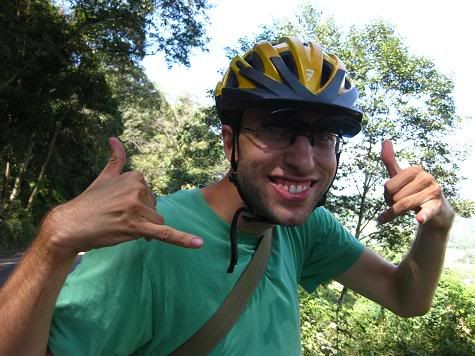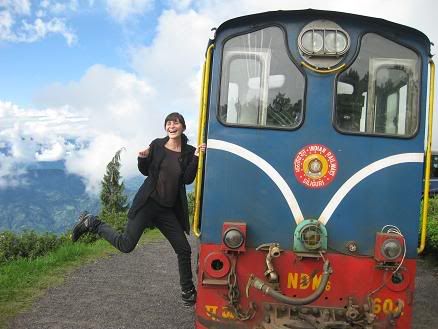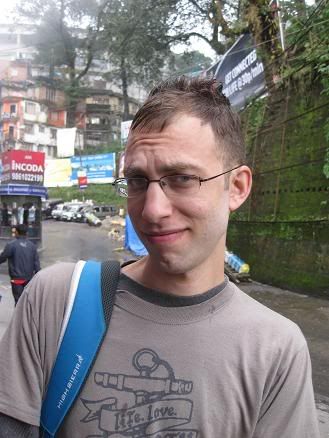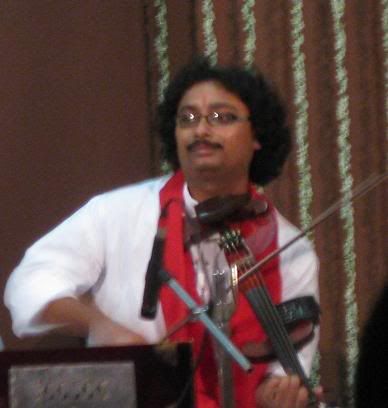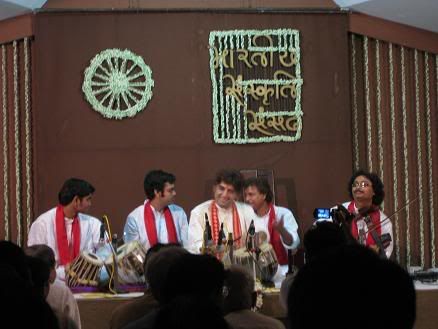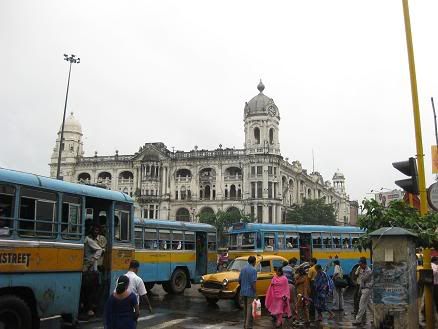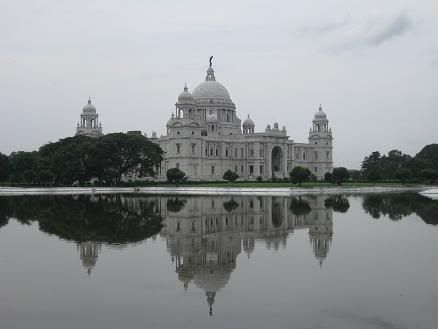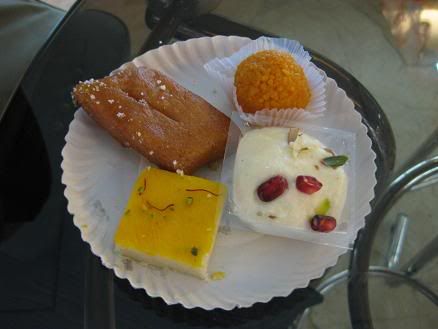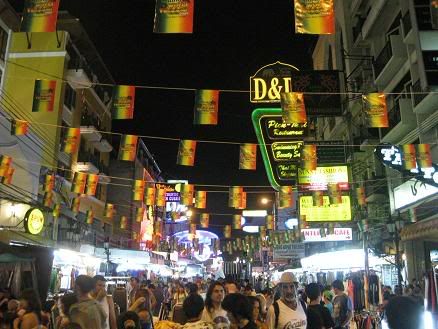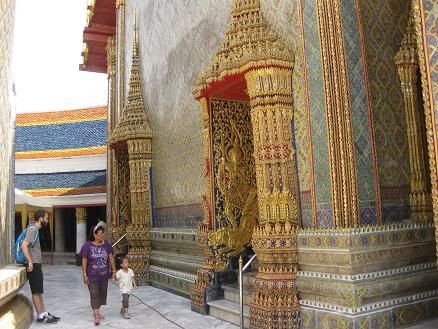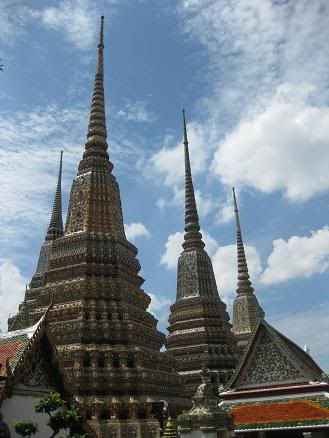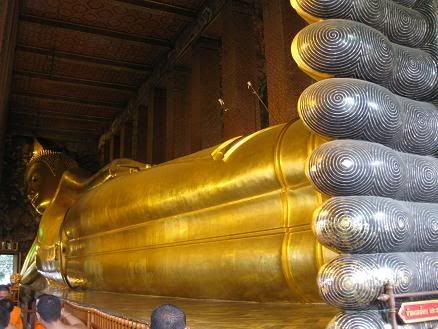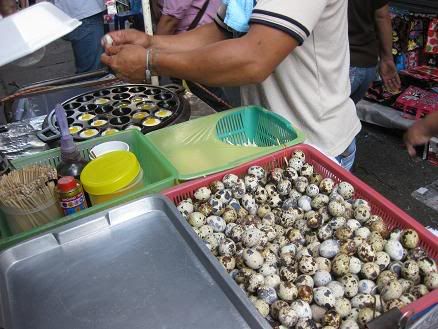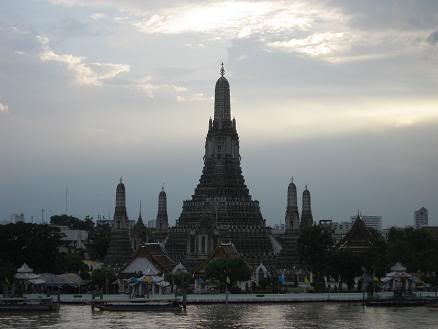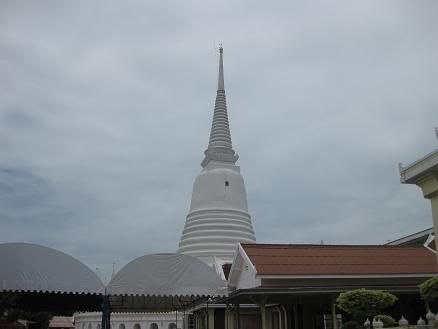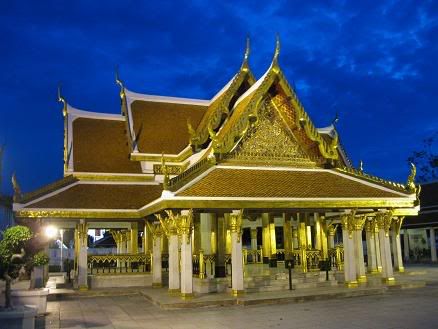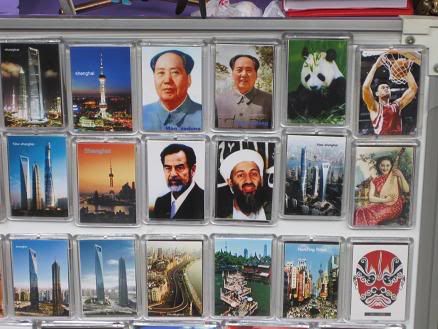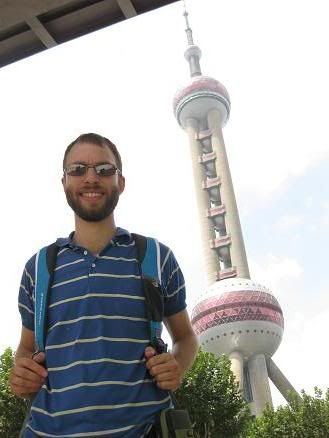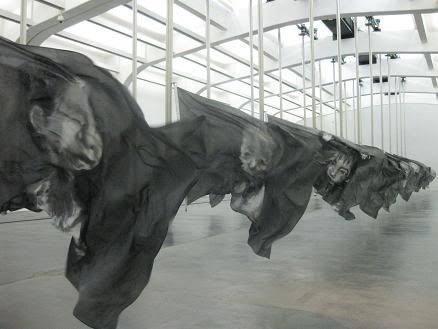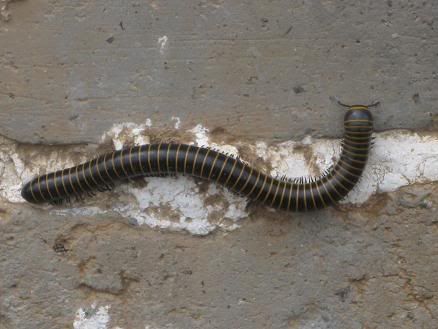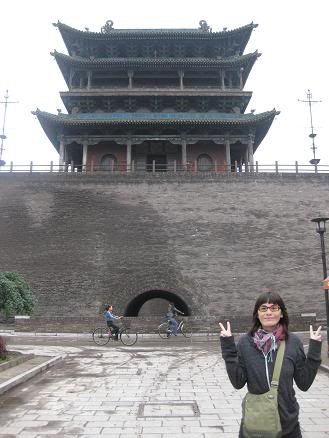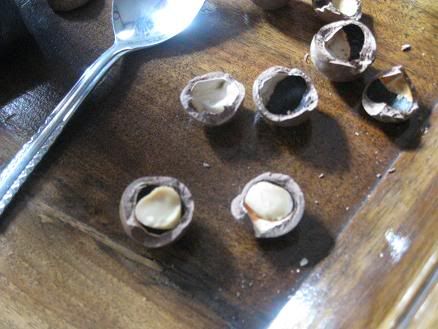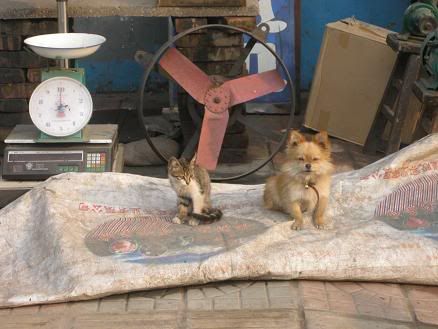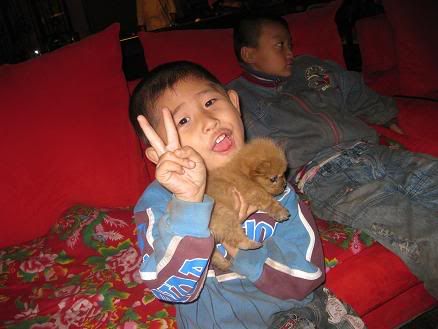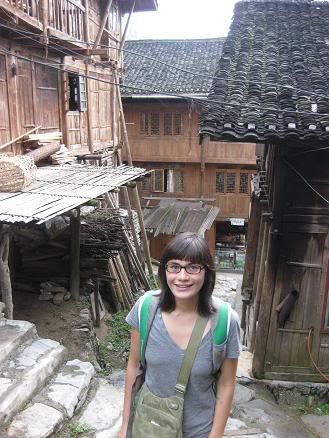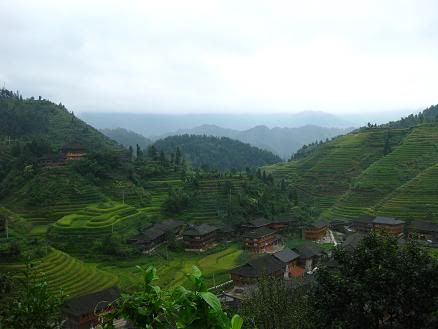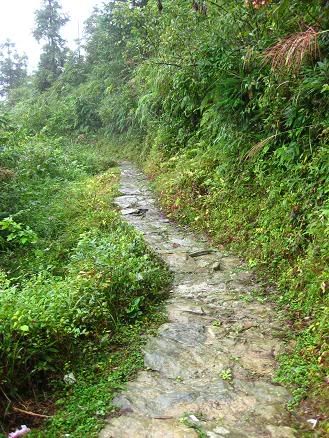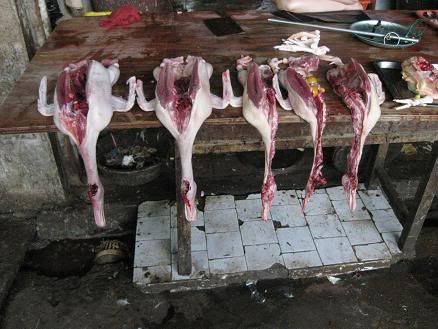The days have somewhat blended together, but I know for that we began our second day here by following one of Lonely Planet's excellent walking tours, which led us through one of Kathmandu's ancient market neighborhoods. As we ventured through various alleyways and busy commercial streets, I kept trying to locate all of the various little temples and shrines that were mentioned in the book. Sometimes, they were easy to find. But other times, we had to get lost a little bit before we could find it. As I've mentioned many times before, getting lost in big cities is one of my favorite past times, and Kathmandu has some amazing little streets and courtyards.
The tour eventually led us down one of Kathmandu's oldest commercial streets. Here, we had to wade our way through the intense traffic. It was a brutal combination of pedestrians, motorcycles, trucks and bicycle rickshaws.

At one point, one of Nepal's notorious Sadhus (holy men) approached me out of nowhere and put a smudge of red powder on my forehead. He then gave me a little flower and did the same to Mimi. Then he asked for money and said we could take his picture. This perplexed me. Why is a man who has dedicated his life to wandering the earth in search of spiritual enlightenment so concerned with collecting cash payments for photos with tourists? Everybody's gotta get paid, I suppose. Here is a picture of the mystery Sadhu:

Eventually, we made our way over to Durbar Square, which is Kathmandu's ancient city center/royal complex and is teeming with temples and other interesting sites. Traveling through Asia, one can easily come down with a case of what I like to call Temple Overload. One could argue that if you've seen one temple you've seen them all. Sometimes this is true, and sometimes it isn't. Kathmandu's Durbar Square, however, offers a very unique temple experience. It gave me new perspective on what a temple is and what it can mean to its people.
Many temples throughout Asia are deservedly behind a protective perimeter of concrete walls. This turns the temple into a place of refuge; a quiet place that where you can retreat to when the city becomes to much. On the other hand, this can sometimes make a temple feel a bit sterile. Add an admission fee and a busload of Italian tourists, and what used to be a temple now feels like a museum. A city's best temples often suffer this fate. They no longer feel like they are serving their original religious purpose, and pious locals often choose to go somewhere else instead.
Kathmandu's Durbar Square was completely different. Although there was an admission fee, there was no gate. The ticket simply grants you access to an entire neighborhood of Kathmandu. Once inside Durbar Square, I quickly realized that nearly every building in sight was hundreds of years old. Temples and shrines abounded. The interesting part though, was that beyond this ancient architecture, Durbar Square was no different from any other neighborhood we had seen. Traffic was heavy and people were on the move. People went about their daily business as if the temples weren't even there. More often than not, the structures were used not as a place of worship, but as a place to hang out and watch the city go by. In essence, nothing was off limits. It wasn't a museum. So instead of staring at the buildings from afar, people were just hanging out in and on them. They were part of the city.
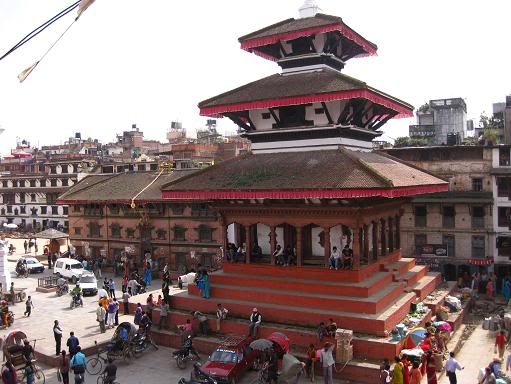
The downside to this system is that many of the buildings have deteriorated considerably over the years. Some of the buildings are over 1,000 years old and I was allowed to go inside and touch anything that I wanted. It was cool, but I guess there is something to be said for conservation as well. Another downside to this free system is that the whole area was grossly infested with "tour guides." I can't say whether or not these guys would have been a good tour guide, but I can say with certainty that they were very good at annoying the hell out of me. How many times can I tell you that I don't want a tour guide before you leave me alone? At one point, nearly at the end of my patience, I told one of the tour guides to simply, "LEAVE US ALONE." He responded, "Hey man, we're not the Taliban, we don't kidnap people." The absurdity of this comment caused my blood to boil. Did I imply that I was afraid he was going to kidnap me? I felt that he had unfairly played the "race card." Luckily I've come to learn that cooler heads prevail and let it go.
Speaking of cool heads, while at Durbar Square we were fortunate enough to hang out with some more Sadhus. Again, these guys seemed far more concerned with lining their wallets with tourist rupees than they were with reaching Nirvana. They looked totally awesome though and Mimi and I joined in on the fun. Jimmy Buttons, if you are reading this, you have some serious competition out here in Nepal. Look at these dreds!


The next day we got up early went straight back out on the "sightseeing" circuit. The first stop was Swayambhunath, a very interesting and lively Buddhist complex that sits atop a hill just on the Western outskirts of the city. It wasn't too far from where we were staying, so we decided to walk. This took us through a rather drab, dirty part of town, but after about a half hour, we arrived at the base of the hill. All we had to do then was climb the stairs.
Swayambhunath is known for its very large Stupa and panoramic views of Kathmandu. A stupa is a large white dome with a gold top, and it is often the center piece of Buddhist temple complexes. The stupa here was quite large and impressive, as was the view of Kathmandu from the top of the hill. It was also interesting to watch local Nepalis being blessed by the resident monks. But let's be honest. The real reason Swayambhunath is such a popular tourist destination is because the entire hill is home to perhaps two hundred incredibly adorable wild monkeys. Who doesn't like monkeys? It is for this reason that Swayambhunath is more commonly refered to as the monkey temple, at least by Westerners and Nepalis who work in the tourism industry. So lets forget about the stupas and gompas and all that and enjoy some pictures of cute monkeys.
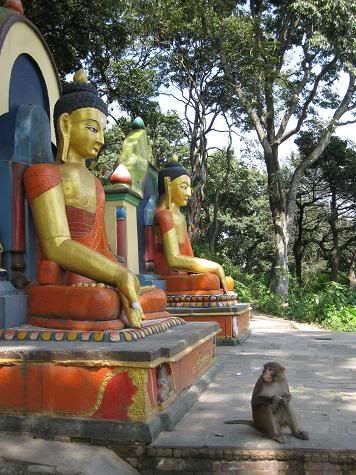
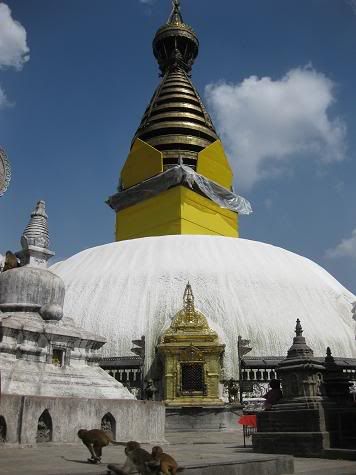
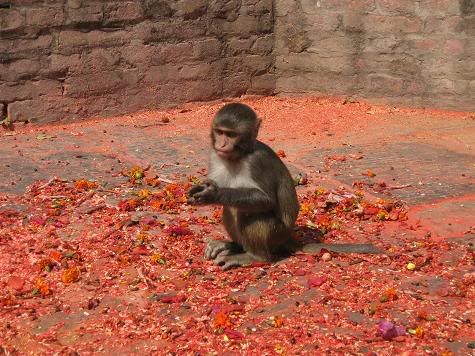
After about an hour of laughing and pointing at monkeys, we had finally had our fill. We walked down the opposite side of the hill and tried to locate the Kathmandu Natural History Museum, which was supposed to be a quirky, off the beaten track destination. Indeed, we were definitely the only people in the small museum. In fact, it seemed as if we were the only people who had visited in weeks, and that nothing had even been touched or altered since the late 1970s. Inside we found a bizarre collection of animals that had either been stuffed or preserved in fermaldahyde. This included including snakes, birds, carnivores, and pretty much anything else you can imagine. The highlights were definitely the jarred rhinocerus fetus and petrified "elephant scat." Quirky indeed.
The museum was pretty small and after about a half hour we got on our way and left 7th grade science class behind us. After a bit of debate, we decided that we wanted to check out the Durbar Square in Patan. Patan is the second largest city in the Kathmandu Valley and as a result of population expansion is essentially part of Kathmandu. The only thing separating the two cities at this point is a small trickle of a river. After an intense negoation with a taxi driver, we were on our way. Needless to say, we immediately hit traffic and the ride was a bit longer than we had hoped.
It was well worth it though because Patan's Durbar Square was amazing. It offered equally impressive ancient pagodas and courtyards, but half the tourists and would-be tour guides. Mimi took some amazing photos of both of the Durbar Squares which we will hopefully get uploaded soon. I will make a post once those photos are online. While we were walking around the square we noticed a group of people huddled around something. At first, I assumed it was another Sadhu flaunting his dreds. But upon closer inspection we realized it was actually a group of Spanish tourists that had somehow launched their own variety show. It was a bizarre sight, watching all the local Nepalis stare with confusion at this group of Spaniards belted out classic Spanish tunes and jokingly passing around a hat for donations.
After Durbar Square we followed another one of Lonely Planet's walking tours. This one led us through another amazing series of alleyways and courtyards. As in Kathmandu, it was remarkable how these ancient religious shrines and statutes blended seemlessly into the neighborhood. It was also an interesting walk because even though we were only a few blocks away from Durbar Square, we quickly became the only tourists anywhere in sight. Local residents often seemed surprised to see us there. We found this to be true everywhere in Kathmandu. Go just the slightest bit off the tourist track and you're guaranteed to be the only Westerner in sight.
At this point, we had been out and about all day and as the sun began to set we realized it was time to get back to Thamel. We were in no mood to negotiate with another taxi driver so we decided to have a go with the intimidating but everpresent minibuses. As I mentioned in a post long ago, I first became aware of this mode of transportation back in Cairo. A minibus, which is also sometimes called a microbus, is basically a privately-owned van or minivan that ferries people around town. A driver sits up front, and as always, his assistant screams the bus' destination out the window and collects money. For a long time we had been intimidated by these buses. What if we misunderstand the man and end up on the wrong side of town? What if he tries to overcharge us? Minibuses are a strictly local affair and tourists (read: white people) rarely, if ever use them.
But today was the day. After an initial round of confusion and doubt, we eventually found the a bus that we were reasonably positive was headed in the right direction. The driver waited until all the seats were filled and we were on our way. Then came the crush. This van put the phrase "like sardines in a can" to complete shame. As the blocks went by, more and more people climbed into the van. The yeller/money collecter was always the last man back into the van, and would often jump back through the open side door long after the driver had hit the accelerator. As bodies climbed passed me and eventually on top of me, I realized it was time to count how many people were in this vehicle. At its peak, the van, which by Western standards might seat 8 or 10 people, had packed in an impressive if not entirely uncomfortable 26 bodies.
The ride, while not particularly comfortable, was a complete success. We were dropped off within walking distance of our hostel and had paid a tenth of what a taxi would have cost us. Having broken down our fear of the minibus, we were ready for more. In fact, we've been taking them everywhere since.
Before we had left the United States, Mimi had heard from a friend about a wonderful guest house just outside of Kathmandu. The Schehen Guest House is attached to a large but modest Buddhist Monastery in a surburb of Kathmandu called Bouhda. We were able to get a reservation a few days before, so on our fourth day in Kathmandu, we packed an overnight bag and headed out to Bouhda for three nights.
To our delight, the Schehen Guest House has been completely amazing. Inside a walled monastery complex, the guest house is serene and quiet. There is a nice garden courtyard and a decent vegetarian restaurant here as well. We are right next to the monks' sleeping quarters and can hear them chatting during the evening. One morning I was woken up quite early by a man doing what I believed were incredibly loud yoga breaths. It went on for an hour! Kathmandu can be a very overwhelming city, and the Schehen Guest House was the perfect antidote. Here is a picture of the main monastery building:

The main attraction in this area is the Bodhnath stupa, which is one of the world's largest Tibetan Buddhist stupas and is a major pilgrimage site. The stupa dates back to 600 AD and was quite interesting to walk around. Everyone walks around it in a clockwise direction and around evening time many local people come out and stroll around it in circles. As a result of the stupa's importance, numerous monasteries have popped up over the years in the surrounding area. Our monastery was about a five minute walk down a back alley from the main stupa. The Bodhnath Stupa forms the center of a town square, and in this regard it almost reminded me of an Italian plaza.

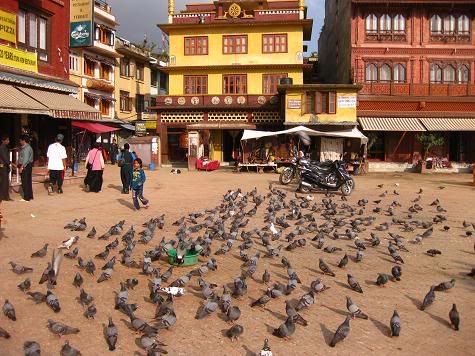
After checking out main stupa we decided to check out one of the nearby monasteries. It was here that I had an experience that left a bit of a sour taste in my mouth. We walked up to the third floor and checked out the various paintings and prayer areas. At this point a monk approached us and offered to take our picture. We obliged and then he took us to a side area and gave us good luck charm and let us light a prayer candle. It was all very nice, and we knew he might ask for a donation. But it caught me a little off guard when he asked, "Do you have American money?" We said no, to which he replied, "OK. 500 rupees please." This is equal to about $7 USD. We looked at him like he was crazy and gave him 40 rupees and left the monastery. As we walked down the stairs, Mimi and I talked about how absurd it was for him to ask for so much. After all, we had already put a small donation in the general donation box, which we assumed would go to the monastery as a whole and not just one monk.
That experience, in combination with some other obversations, has led me to rethink my assumptions about Buddhism. I think that many of us in the West an unrealistically positive, romantic vision of what Buddhism is, and in particular Tibetan Budhism. Unlike Catholicism or Evangelical Christianity, we think of Buddhism as an uncorrupted, decentralized religion that is centered on individual growth and not on (financial) servitude to a God or institution. We tend to think of Tibetan monks as very pure and selfless people. I know that personally whenever I see a monk in an airport or somewhere wearing his maroon robe and sandals, I think to myself, "That monk looks awesome, I bet he is very at peace with himself." But in reality, monks could be just like you or me. Around Bodhnath, it is not uncommon to see a monk blazing through the alleys on his motorcycle or showing off his newest ringtone. I'm not saying that monks should be like the Amish, but it definitely surprised me.
The role that money plays in Buddhism also definitely caught me off guard. We all know that Marx said that religion was the opiate of the masses, and sometimes Buddhism, despite its claim of not technically being a religion, falls rights into that mold. Why else would poor Nepali people come to these temples and throw their money at the monks and Buddha statues? I understand that in many religions and cultures money is often equated with good luck, but I can't help but think that the money might be better spent elsewhere. On the flipside, if this is bringing people happiness and a bit of hope, then perhaps it is money well spent. But when it has evolved into a monk asking me for $7 because he let me light a candle, then there is a serious problem.
That being said, as we wandered further away from the main stupa, we found another monastery that painted a different picture. Here, perhaps fifty young monks (some as young as nine or ten) were diligently reciting their texts and passing them along down a line. The sound of all of their voices reciting the lines with differing intensity was very intense and mezmorizing. Many new thoughts popped into my head. Were these monks orphans? Or did their parents have to pay for them to be accepted into the monastery? Were they happy to be there? What is the relationship between the older monks and the younger monks? Is molestation a problem in Buddhist monasteries the way it is in the Catholic church?
We spent the rest of the day relaxing in the garden at our guest house. I also bought a little book written by a Buddhist scholar about how to lead a tolerant, peaceful life. I know that any system with such rigid guidelines and required devotion is not for me, but I still feel like there is much to be learned from Buddhism and at the very least, perhaps I can reduce my stress level!
I am now only three days behind in my reporting. I am trying my hardest to keep up. The last few days have been totally amazing. In preparation for our trek, we have been venturing out into the more remote areas of the Kathmandu Valley for some mountain bike riding and hiking. Along the way we saw some amazing temples that were totally unscathed by the tourist hordes, wandered through several amazing villages, said Namaste (hello) to dozens of shy but friendly rural Nepalis, set off firecrackers with a group of young boys, and even waded through a river! I will write about it all in more detail as soon as I can find the time. Until then, hang loose!
